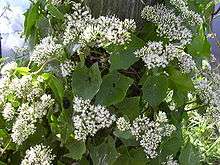Mikania scandens
Mikania scandens is a species of flowering plant in the aster family, Asteraceae. Its common names include climbing hempvine, climbing hempweed, and louse-plaster.[1] It is native to the eastern and central United States, its distribution extending into Tamaulipas in Mexico.[1] Reports of its presence in Ontario in Canada are erroneous.[2] It is an introduced and invasive species on many Pacific Islands[3] and in parts of southern Asia.[4]
| Mikania scandens | |
|---|---|
 | |
| Scientific classification | |
| Kingdom: | |
| (unranked): | |
| (unranked): | |
| (unranked): | |
| Order: | |
| Family: | |
| Genus: | |
| Species: | M. scandens |
| Binomial name | |
| Mikania scandens | |
| Synonyms | |
|
Eupatorium scandens | |
Description
This species is a perennial herb which grows as a branching vine. The leaves are oppositely arranged at swollen nodes on the stem. They have triangular or heart-shaped, sometimes toothed blades up to 15 centimeters long by 11 wide. The flower heads are clustered in panicles. The flower head is about half a centimeter long and is enclosed in narrow, sometimes purple-tinged phyllaries. The flowers are pinkish, purplish, or white. The fruit is a dark-colored, resinous achene about half a centimeter long, including its pappus of white or purplish bristles.[2][3]
Biology
The pappus-tipped seeds are dispersed on the wind or on clothing or fur. The plant also reproduces vegetatively by rooting from the nodes on sections of stem.[3] The climbing herbage can become weedy and dense, sometimes covering other vegetation.[5] It also has allelopathic effects on other plants.[4]
Its native habitat includes wooded areas and swamps.[3]
This is a host plant for the larvae of the Little Metalmark (Calephelis virginiensis), and the adult consumes the nectar.[6]
Uses
This plant is cultivated as a cover crop and a livestock fodder. It is also grown as an ornamental plant[3] and it is used in butterfly gardens.[6]
It is used in traditional medicine systems of the Indian subcontinent as a treatment for gastric ulcers, wounds, and insect bites and stings.[7]
References
| Wikimedia Commons has media related to Mikania scandens. |
- "Mikania scandens". Germplasm Resources Information Network (GRIN). Agricultural Research Service (ARS), United States Department of Agriculture (USDA). Retrieved 21 January 2018.
- Mikania scandens. Flora of North America.
- Mikania scandens. Pacific Island Ecosystems at Risk (PIER).
- Piyasena, K. and H. Dharmaratne. (2013). Allelopathic activity studies of Mikania scandens. Natural Product Research 27(1), 76-79.
- Moon, M., et al. (1993). Acclimatization to flooding of the herbaceous vine, Mikania scandens. Functional Ecology 7(5), 610-15.
- Mikania scandens. Natives For Your Neighborhood. The Institute for Regional Conservation, Florida.
- Dey, P., et al. (2011). Neuropharmacological properties of Mikania scandens (L.) Willd.(Asteraceae). Journal of Advanced Pharmaceutical Technology & Research 2(4), 255-59.
